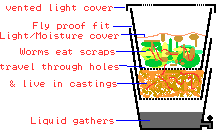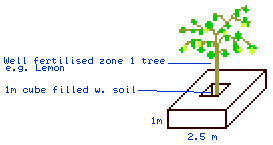
Written by Mitra Ardron in Australia
A Worm farm is an easy way to recycle kitchen scraps. In the process it produces liquid and solid fertilizers and worms. Worm farms shouldn't smell, and are convenient for urban, or even balcony, gardens where compost piles might not be appropriate.
Three Different Systems[edit | edit source]
Three of the many possible systems are shown below, they all use similar principles, and can be adapted to different circumstances.
Stacked Bin System[edit | edit source]
Construction: In this system, a set of three or four stacked bins are used. Ideally, they need to fit together tight enough that larger flys can't get in, but slide enough that the top bin rests on top of the castings in the tray beneath it, this is important because the worms live in the castings of the second tray from the top, migrating up to the food scraps to eat. Some ideas for bins to try might be large plant-pots, or yoghurt pots, or some kind of stacking storage system. We haven't tried any of these, so we'd love to hear reports. The other alternative is to buy a set of trays designed for this, for example in Australia, Reln plastics make a couple of designs from recycled plastic that works well. Start it off by mixing compost and scraps in the top tray, and adding 1000 worms. Cover with something that will keep the light out, and the moisture in, for example wet newspaper, hesian or upside-down carpet.
Operation: Just add kitchen scraps to the top tray, when the tray is more than about 2/3 full with partly digested scraps, you can remove the bottom tray, empty out any castings from it, and move it up to the top. Make sure the castings the worms are living in (2nd tray down) stays moist, you can just pour some water into the top.

Bulk processing in a bath[edit | edit source]
This is a much larger scale system, place an old bath on some rocks or bricks, high enough to get a bucket underneath the plug-hole. Make sure that it drains towards the plug. Fill it with either a mix of 2/3 manure, and 1/3 scraps or prunings or just processed compost. Make sure the manure doesn't come from animals treated recently for worms. If you shred the scraps then the process will be quicker. Put in at least 1000 worms. Cover with a lightproof cover, that will let the rain through. For example scrap carpet (fluffy side down) or hessian.
Leave it for about 3 months. Feeding about 20 litres of scraps a week in summer. Then open to the light, remove any still fresh scraps, and put chopped scraps at one end, and re-cover. The next day you can collect most of the worms which should be in the fresh scraps. Take out the castings into a pile, leave for about 10-20 minutes for the worms to borrow away from the light, and then remove the outside 3 centimeters to a new pile. Repeat every 10-20 minutes as the worms borrow towards the center.
Climatic considerations:
In the Wet tropics you'll need to cover from rain and shade from the sun.
In colder climates - where there is a ground-frost or snow then insulate for winter, for example with straw bales. Don't feed since the worms will go dormant but live through the winter.
In Arid climates this will need watering.
Continuous system - garden seat design[edit | edit source]
This system is similar to the bath system, except that its designed for continuous usage, a garden seat is constructed, about 2.5m on each side, and a metre high.This size would suit a 1000m2 site, such as an Australian suburban block. A metre cube in the middle, is filled with soil and a Zone 1 tree that will be very well fertilized. The seat is started with a mixture of scraps, compost and worms. The system generates castings continuously, scraps being added at one end, and fertilizer removed at the other end. The down-side is that you can't collect the liquid fertilizer seperately, it will soak into the soil - and fertilize the tree. The up-side is that, unlike an old bath, it makes an attractive feature in the garden.
Food
Worms will eat pretty much anything thats organic, they eat their own weight in food every day, so keep them well fed. Its better not to feed them onions, citrus or meat scraps, although they'll eat these once everything else is used up. Feed the worms when the scraps are almost used up, but you can't over-feed the worms.
Do not feed them manure from recently wormed animals, the residue of the de-worming drugs will kill your compost worms as well.
There are various diets that can be used to fatten them up, for example if you want to use them for fishing.
Usage
The Castings - the earth like material left after the worms have eaten the food. Is a high grade fertilizer, add it to potting or seed raising mixes, or use as a compost substitute, it contains worm eggs.
The Liquid, or "worm juice" that drains out the bottom is a really strong fertlizer, dilute it about 20:1 and use it as a folio feed, i.e. spray it onto leaves. Or use it as a liquid fertilizer, especially for productive trees.
The Worms can be added to mulched gardens. Since the worms double their population every 40 days, you should have an endless supply of worms for your gardens, compost worms are not the same species as earthworms. They'll eat the mulch layer but not burrow down and loosen the soil, so they are only really valuable if you are using lots of mulch. The worm-juice and castings contain lots of worm eggs, so if you fertilize with these you should end up with compost worms as well. Problems
Drying Out: Moisture control can be a problem, although the worms are tolerant of a range of conditions. Normally the food contains enough moisture for the worms. If you aren't sure then use the "squeeze test", pick up a handfull of castings and squeeze in your fist, if just a few drops come out, then its just right. If its too wet, then the problem is probably that the system needs better shielding from rain. If its too dry you can pour water on top.
Bugs: You are bound to get other bugs where there is such an abundant supply of food, usually this is not a problem unless there are meat scraps in the food. Bugs are all part of nature's way of turning food into compost. Large flies are easily kept out by making sure the food is covered, you'll probably get lots of really tiny flies called compost flies, these can get in through the ventilation holes, they aren't a problem. You might find a lot of oval maggots about 1.5cm * 0.5cm, these are the lava of the tiny little compost flies and are also a healthy part of the decomposition process. If you don't cover the worm farm sufficiently you might get problems with birds or animals.
Mould is usually a sign that you are feeding the worms more than they can eat, so some is being left for the mould to breakdown, alternatively it can be because the worms are leaving some particular food (for example citrus) for something they prefer to eat. This is not a big problem, just reduce the amount of food.
Putrification is another sign of over feeding with foods that are high in nitrogen, you can balance this by adding dry material that is high in carbon e.g. sawdust, wood scraps or newspaper.
If it gets Soggy, its probably a blocked drainage, poke this out.
If you have a food shortage, then you can feed the worms any organic matter, for example gardening cuttings (e.g. flowers), sweet potatoe leaves, grass clippings, or weeds, but avoid putting weed-seeds in or they'll end up in your compost.
Credits: Authored by Mitra, from information supplied by Geoff Lawton of Permaculture Research Institute. http://www.mitra.biz/howto_wormfarm.htm

